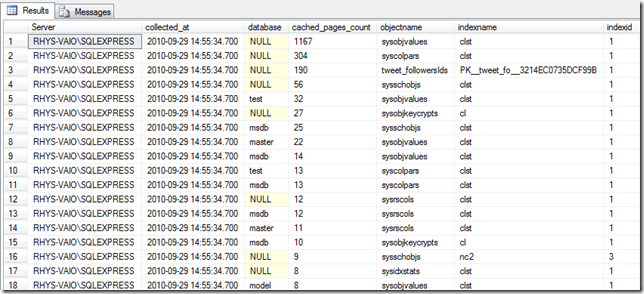Gathering SQL Server Data Cache Information: Part 2
In a previous post I showed how you can collect information on what is held in the data cache. The data collected here was just a simple summary of how much space each database was consuming. While useful we will need more detailed information on what is inside the cache to get a proper handle on things.
The below query has been modified from the post: What’s swimming in your buffer pool? This procedure will tell us exactly what objects are contained within the data cache.
SET ANSI_NULLS ON
GO
SET QUOTED_IDENTIFIER ON
GO
-- =============================================
-- Author: Rhys Campbell
-- Create date: 2010-09-28
-- Description: Gets info on objects in the data
-- cache broken by database.
-- =============================================
CREATE PROCEDURE [dbo].[GetDataCacheObjects]
AS
BEGIN
-- SET NOCOUNT ON added to prevent extra result sets from
-- interfering with SELECT statements.
SET NOCOUNT ON;
SELECT @@SERVERNAME AS 'Server',
GETDATE() AS collected_at,
DB_NAME(database_id) AS 'database',
COUNT(*)AS cached_pages_count,
obj.name AS objectname,
ind.name AS indexname,
obj.index_id AS indexid
FROM sys.dm_os_buffer_descriptors AS bd
INNER JOIN
(
SELECT object_id AS objectid,
object_name(object_id) AS name,
index_id,allocation_unit_id
FROM sys.allocation_units AS au
INNER JOIN sys.partitions AS p
ON au.container_id = p.hobt_id
AND (au.type = 1 OR au.type = 3)
UNION ALL
SELECT object_id AS objectid,
object_name(object_id) AS name,
index_id,allocation_unit_id
FROM sys.allocation_units AS au
INNER JOIN sys.partitions AS p
ON au.container_id = p.partition_id
AND au.type = 2
) AS obj
ON bd.allocation_unit_id = obj.allocation_unit_id
LEFT OUTER JOIN sys.indexes ind
ON obj.objectid = ind.object_id
AND obj.index_id = ind.index_id
WHERE bd.page_type IN ('data_page', 'index_page')
GROUP BY DB_NAME(database_id), obj.name, ind.name, obj.index_id
ORDER BY cached_pages_count DESC
END
GO
This will produce a dataset similar to below.
This proc can be called by the Powershell script in the previous post (nice and easy to run against multiple servers) and will produce a csv file looking like below. Just change the line
$proc = "EXEC dbo.GetDataCache";
to
$proc = "EXEC dbo.GetDataCacheObjects";
This is ready to be imported into a database for future analysis.
"Server","collected_at","database","cached_pages_count","objectname","indexname","indexid"
"RHYS-VAIO\SQLEXPRESS","29/09/2010 14:58:32","","1167","sysobjvalues","clst","1"
"RHYS-VAIO\SQLEXPRESS","29/09/2010 14:58:32","","304","syscolpars","clst","1"
"RHYS-VAIO\SQLEXPRESS","29/09/2010 14:58:32","","190","tweet_followersIds","PK __tweet_fo__ 3214EC0735DCF99B","1"
"RHYS-VAIO\SQLEXPRESS","29/09/2010 14:58:32","","56","sysschobjs","clst","1"
"RHYS-VAIO\SQLEXPRESS","29/09/2010 14:58:32","test","32","sysobjvalues","clst","1"
"RHYS-VAIO\SQLEXPRESS","29/09/2010 14:58:32","","27","sysobjkeycrypts","cl","1"
"RHYS-VAIO\SQLEXPRESS","29/09/2010 14:58:32","msdb","25","sysschobjs","clst","1"
"RHYS-VAIO\SQLEXPRESS","29/09/2010 14:58:32","master","22","sysobjvalues","clst","1"
"RHYS-VAIO\SQLEXPRESS","29/09/2010 14:58:32","msdb","14","sysobjvalues","clst","1"
"RHYS-VAIO\SQLEXPRESS","29/09/2010 14:58:32","test","13","syscolpars","clst","1"
"RHYS-VAIO\SQLEXPRESS","29/09/2010 14:58:32","msdb","13","syscolpars","clst","1"
"RHYS-VAIO\SQLEXPRESS","29/09/2010 14:58:32","","12","sysrscols","clst","1"
"RHYS-VAIO\SQLEXPRESS","29/09/2010 14:58:32","msdb","12","sysrscols","clst","1"
"RHYS-VAIO\SQLEXPRESS","29/09/2010 14:58:32","master","11","sysrscols","clst","1"
"RHYS-VAIO\SQLEXPRESS","29/09/2010 14:58:32","msdb","10","sysobjkeycrypts","cl","1"
"RHYS-VAIO\SQLEXPRESS","29/09/2010 14:58:32","","9","sysschobjs","nc2","3"
"RHYS-VAIO\SQLEXPRESS","29/09/2010 14:58:32","","8","sysidxstats","clst","1"
"RHYS-VAIO\SQLEXPRESS","29/09/2010 14:58:32","model","8","sysobjvalues","clst","1"
"RHYS-VAIO\SQLEXPRESS","29/09/2010 14:58:32","model","8","sysrscols","clst","1"
"RHYS-VAIO\SQLEXPRESS","29/09/2010 14:58:32","tempdb","8","sysobjvalues","clst","1"
"RHYS-VAIO\SQLEXPRESS","29/09/2010 14:58:32","tempdb","8","sysrscols","clst","1"
"RHYS-VAIO\SQLEXPRESS","29/09/2010 14:58:32","test","8","sysrscols","clst","1"
Once several snapshots of the data cache have been made this should help us with performance problem diagnosis and estimate the “warm-up time” after a reboot.
